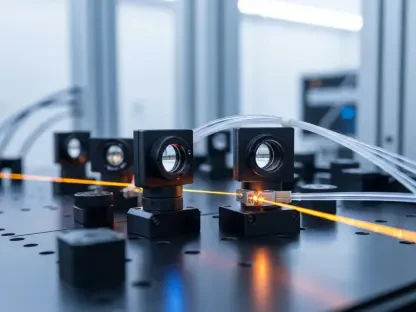In a monumental leap for quantum photonics technology, researchers at Boston University, UC Berkeley, and Northwestern University have crafted the world’s first integrated electronic-photonic-quantum chip using a standard 45-nanometer semiconductor process. This advancement promises to significantly impact computing, sensing, and secure communication by integrating quantum light sources with classical electronic components on a single chip. The creation of such a device using commercial chip manufacturing techniques marks a crucial step toward developing scalable quantum systems. Traditional quantum systems require complex, often large-scale setups to produce quantum states, yet this innovation brings that capability into a compact form by embedding quantum light sources onto a semiconductor platform widely recognized in the industry. The chip hosts twelve independent quantum light sources referred to as “quantum light factories.” Each of these sources generates streams of correlated photon pairs essential for executing quantum processes. These factories are powered by laser light and utilize microring resonators known for their precision yet sensitivity to external disruptions like temperature variations.
Pioneering Integration of Quantum Light Sources
The integration of quantum light sources within a classical electronic framework has long posed a formidable challenge due to the precision and stability required to successfully operate quantum systems. Quantum technologies are notoriously delicate, susceptible to environmental factors that can lead to misalignments and ultimately to the degradation of the quantum state. Addressing this intricate issue, the research team has embedded a real-time control system within the chip itself. This system employs sophisticated on-chip photodiodes, integrated heaters, and advanced control logic to consistently detect and correct any deviations from optimal operation. By maintaining consistently stable quantum light generation despite external influences, this approach bridges the gap between classical electronics and the stringent conditions required by quantum photonics. The achievement of such seamless integration demonstrates the crucial role that carefully crafted control mechanisms play in ensuring the operational integrity of complex quantum systems. As the development of quantum technologies progresses, this capability for precise control and stability will be indispensable in the practical deployment of these systems across various applications.
Commercial Manufacturing Techniques in Quantum Technology
Highlighting a major trend in quantum engineering, this project showcases the feasibility of leveraging existing commercial semiconductor processes in quantum device fabrication. The utilization of the 45-nanometer CMOS platform exemplifies a strategic shift towards using tried-and-true manufacturing techniques to accommodate the specialized demands of quantum photonics. This is more than a simple evolution; it represents a pivotal moment in quantum technology development. By harnessing standard commercial technology, the team demonstrated that the creation of sophisticated quantum elements need not rely on bespoke processes, thus paving the way for more cost-effective and scalable quantum solutions. This approach could significantly enhance the accessibility of quantum computing and communications technologies, potentially ushering in a new era where these devices become commonplace. The implications for this are vast, with the potential to influence sectors ranging from secure communications to advanced computational models that benefit industries as diverse as healthcare, finance, and artificial intelligence.
Collaborative Innovation in Quantum Research
The success of this endeavor underscores the power of collaboration across diverse fields traditionally operating independently. Partnerships between academic institutions, such as the involvement of Boston University, UC Berkeley, and Northwestern University alongside industry giants like GlobalFoundries and Ayar Labs, illustrate the importance of interdisciplinary cooperation in this field. Such collaborations bring a range of expert insights, technical prowess, and innovative methodologies that prove essential in tackling the complex challenges inherent in quantum sciences. Support from organizations such as the National Science Foundation and the Packard Fellowship further highlights the critical role of multi-institutional backing in pushing the boundaries of technological exploration. These alliances not only facilitate the sharing of knowledge and resources but also inspire inventive approaches that can accelerate breakthroughs in the field. As quantum technology continues to evolve, fostering such collaborative environments will remain crucial in nurturing advancements that hold the promise of redefining both technological and societal landscapes.
The Future of Scalability and Quantum Photonics
In a significant breakthrough for quantum photonics, researchers from Boston University, UC Berkeley, and Northwestern University have created the first-ever integrated electronic-photonic-quantum chip through a standard 45-nanometer semiconductor process. This innovation stands to revolutionize computing, sensing, and secure communication by fusing quantum light sources with classical electronic elements on one chip. Utilizing commercial chip production techniques, this development is crucial for advancing scalable quantum systems. Traditionally, quantum systems demand complex, bulky arrangements to produce quantum states, but this new chip condenses that ability by embedding quantum light sources onto a widely recognized semiconductor platform. Remarkably, the chip accommodates twelve distinct quantum light sources, termed “quantum light factories.” These factories produce correlated photon pairs, vital for quantum operations. They are powered by laser light and employ microring resonators, known for their precision but also sensitive to external disturbances like temperature changes.









